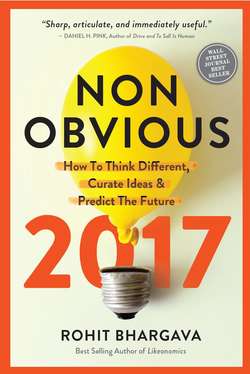Читать книгу Non-Obvious 2017 Edition - Рохит Бхаргава - Страница 11
На сайте Литреса книга снята с продажи.
Science’s Dirty Little Secret
ОглавлениеNow, if you happen to be an analytical person, this process will hardly seem rigorous enough to be believable. How can collecting ideas and waiting possibly be a recipe for developing genuine insights? What about firsthand research? What about trend panels and using a global army of spotters? What about the science?
Well, it turns out science has a forgotten side that has little to do with devising experiments and far more to do with training your powers of observation.
When you think about the discipline that goes into scientific research and the many years of study that lead to a PhD, it is easy to see research as a task only performed by robot-like perfectionists. The truth of scientific research, just like the truth behind many equally complex areas of study, is that the people behind them are far more human than we tend to admit.
In early 2013, a PhD candidate named Beckie Port gathered and published 75 examples of scientists using the hilariously viral hashtag #overlyhonestmethods to share some brutally honest truths about the realities of scientific research.
Among the compilation of tweets Port shared online were these entertaining sound bites:
“Samples were prepared by our collaborators at MIT. We assumed no contamination because, well... they’re MIT #overlyhonestmethods” (@paulcoxon)
“Our representative device is representative of the ones which didn’t immediately explode. #overlyhonestmethods” (@ajdecon)
“Barbados was selected as a case study because the authors had a naive hope that it might justify some fieldwork there. #overlyhonestmethods” (@mlkubik)
“We used jargon instead of plain English to prove that a decade of grad school and postdoc made us smart. #overlyhonestmethods” (@eperlste)
Trends, like science, are not always perfectly observed phenomena that fit neatly into a spreadsheet to be described. Yet this doesn’t mean they don’t have immense value.
Effective scientific research always involves great observation. Scientists learn to observe the results of their experiments and then work to describe them with hypothesis and proof as best they can.
There are many similarities between trends and science, but this is only half the story. Discovering trends takes a willingness to combine curiosity with observation and add insight to create valuable ideas that you can then test to ensure they are valid.
This is vastly different from the method we often mistakenly believe is behind most work with trends: “trend spotting.” This phrase itself is a symbol of the many myths we tend to believe about those who predict or describe trends.
Let’s explore the five most common of these myths.
